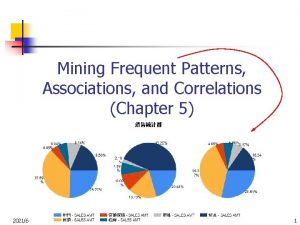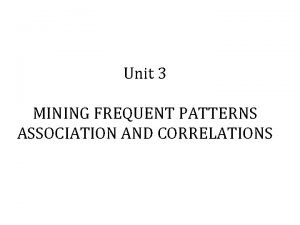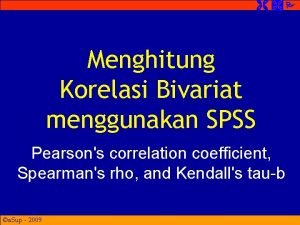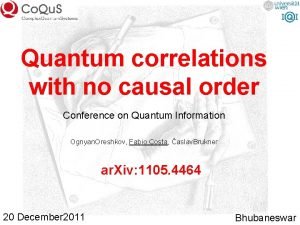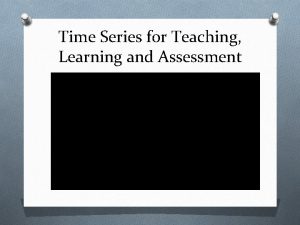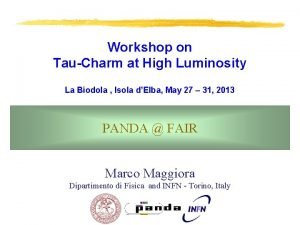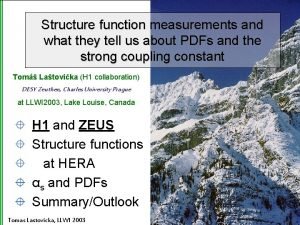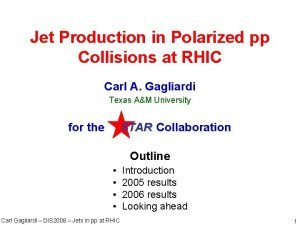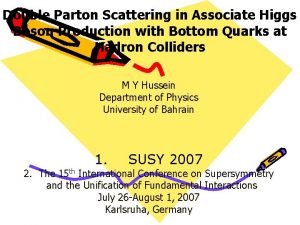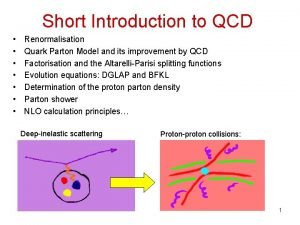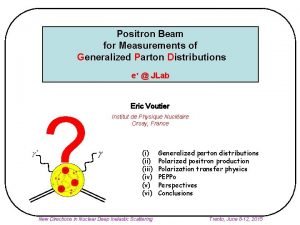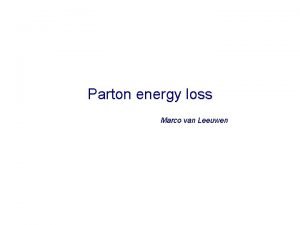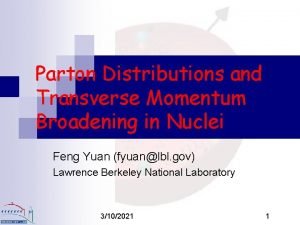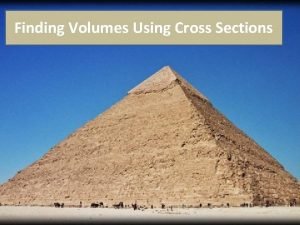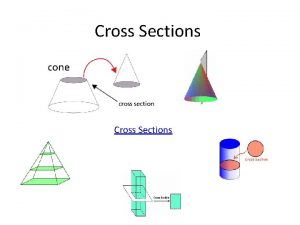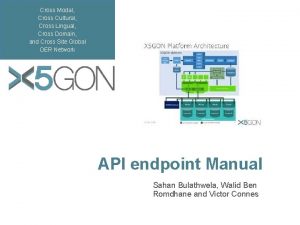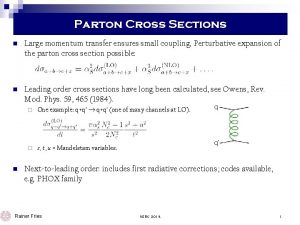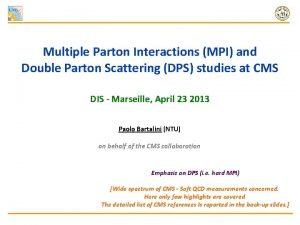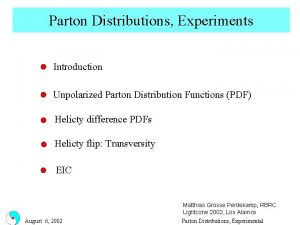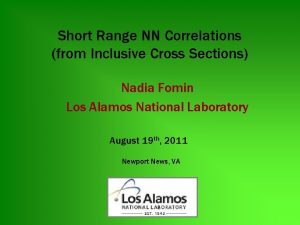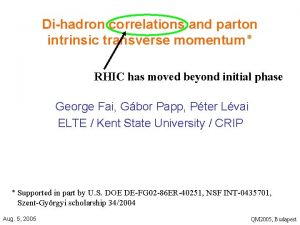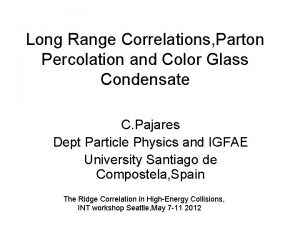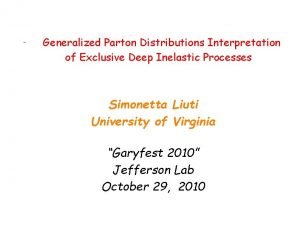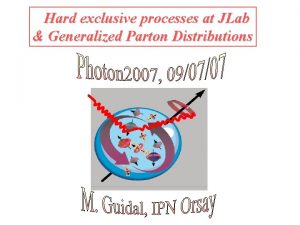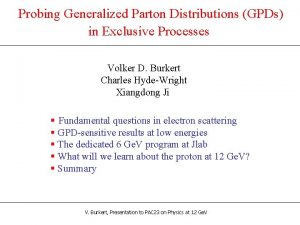Parton correlations and multiparton exclusive cross sections G

















- Slides: 17

Parton correlations and multi-parton exclusive cross sections G. Calucci, E. Cattaruzza, A. Del Fabbro and D. Treleani The rapid increase of the parton flux at small x will produce large rates of events with multiple parton collisions in high energy hadronic interactions

As the scale of the hard interactions is very small in comparison with the hadron size, in a double parton collisions the non-perturbative component is factorized into a function which depends on two fractional momenta and on the relative transverse distance b x 2’ b b x 1’ The inclusive double parton-scattering cross-section, for two parton processes A and B in a pp collision, is given by where are the double parton distribution functions

If partons are not correlated in x, the two-body parton distribution is given by and the expression of the cross section is are geometrical coefficients with dimension an inverse cross section and depending directly on the transverse correlation of the different kinds of partons in the hadron structure

Neglecting all longitudinal correlations and assuming independence on the flavor indices one may easily write the N-parton inclusive cross section s. N

The integrand is dimensionless and after normalization it may be understood as the probability to have N parton collisions: One may hence express the hard cross section s. H (namely the contribution to sinel of all events with at least one parton collision) as Differently form s. S and s. D, s. H is always smaller that sinel and one may write While s. S is divergent when ptc goes to zero, s. H and all contributions to s. H with a given number N of parton collisions are, on the contrary, finite when ptc goes to zero

The single and the double parton inclusive cross sections are given by the average and by the second moment of the distribution in the number of collisions The relations are not specific of the Poissonian case and can be derived on much more general grounds

The different interactions sum up incoherent and the resulting physical picture is purely probabilistic As a consequence one may argue that, while in the previous expressions each final state parton is integrated over the whole phase space with a cutoff in pt, the cross section, in a different rapidity window and with a different cutoff, would have precisely the same poissonian expression. The only difference being in the value of s. S Notice that all contributions to s. H , with a given number of collisions N and s. H itself, are all well behaved for small values of the cutoff One should also point out that all contributions to s. H, , with a given number of collisions N and s. H itself, are all quantities well defined experimentally The physical picture can be generalized including correlations in the multi-parton distribution functions

Multi-parton correlations One may introduce the exclusive n-body parton distributions , and the multi-parton generating functional Probability conservation imposes the normalization condition The many-body densities, i. e. the inclusive distributions are readily obtained:

One may introduce the logarithm of the generating functional and, by expanding in the vicinity of J=1, one obtains the many-body parton correlations A rather general expression for is the following Prob. to find the hadron B in a configuration with m partons Prob. to find the hadron A in a configuration with n partons Prob. to have at least one interaction between the two configurations

This expression for s. H includes all possible interaction (with on-shell intermediate states) between any configuration with n partons of hadron A and any configuration with m partons of hadron B. The cross section complies with the AGK cutting rules. A B disconnected collisions Both A and rescatterings are included in s. H B

A simpler expression is obtained when keeping only disconneced collisions into account, which amounts removing all addenda with repeated indices in the interaction probability Because of the symmetry of the derivative operators, the expression may be replaced by The sums can be performed and the cross section is expressed in a closed analytic form where all disconnected collisions are included, while multi-parton correlations are kept into account at all orders.

The average number of collisions and the second moment of the distribution are obtained when replacing the interaction probability with and with respectively The average number of collisions at fixed impact parameter is hence given by Summing over m and n one obtains which is precisely the QCD-parton model single scattering expression of the inclusive cross section

An analogous argument holds for the second moment of the distribution in the number of collisions. The single and double scattering expressions of the QCD parton model are hence meaningful also in the case of large numbers of parton collisions and represent the first two moments of the distribution in the number of collisions The result holds at all orders in the multi-parton correlations Notice that, in the case of disconnected multi-parton scatterings, the moments of the distribution in the number of collisions correspond to quantities directly measured in an inclusive experiment. e. g. the single jet inclusive cross section measurement performs an average in the number of parton collisions (since the experimental apparatus counts each event with the multiplicity of interactions). When rescatterings are taken into account, the relation between multiple scatterings and the moments of the distribution in the number of collisions is not changed. However, while in the case of disconneced parton collisions the average number of interactions represents precisely the quantity measured in the inclusive experiment, there is no simple relation between the two quantities when rescatterings are taken into account In fact, in such a case, rescatterings contribute to the shadowing corrections of the parton distribution functions

Keeping into account disconnected multi-parton scatterings only and limiting correlations to the two-body case, one writes a gaussian functional integral for the cross section, which allows obtaining a closed expression for s. H D(u) is the average number of partons and C(u, v) the two-body correlation. The final expression obtained for s. H is :

The structures an and bn allow a graphic representation DA CB CB an bn CA DB CA

The correlation term integrates to zero, which allows a further simplification when the correlation lenght is small in comparison to the hadron size. In that case one may neglect all terms an with n > 1 DA CB an a 1 DA DB which is the average number of collisions at fixed impact parameter CA DB

What to be measured ? All relations above are easily adapted to different choices of final state cuts The inclusive cross sections are the moments of the distribution in the number of collisions. Hence e. g. triple, quadruple etc. parton interactions contribute to the inclusive double parton scattering cross section s. D , once taken into account with the proper multiplicity factors. One may obtain further information on the interaction dynamics by measuring, in addition to the inclusive cross sections, also the exclusive cross sections (including s. H itself) in different phase space intervals. All exclusive cross sections are well defined experimental quantities (corresponding to events with a given number of parton interactions only) and are well behaved in the infrared region Explicit expressions, including all effects of the two-body parton correlations, are available both for the inclusive and the exclusive cross sections
 Mutually exclusive vs non mutually exclusive
Mutually exclusive vs non mutually exclusive Mining frequent patterns associations and correlations
Mining frequent patterns associations and correlations Mining frequent patterns associations and correlations
Mining frequent patterns associations and correlations Mining frequent patterns associations and correlations
Mining frequent patterns associations and correlations Dolly parton and mick jagger
Dolly parton and mick jagger Flag significant correlations
Flag significant correlations Quantum correlations with no causal order
Quantum correlations with no causal order Spurious correlations
Spurious correlations Thinking critically
Thinking critically Parton distribution functions
Parton distribution functions Parton distribution functions
Parton distribution functions Parton distribution functions
Parton distribution functions Dolly parton isabelle boulay
Dolly parton isabelle boulay Double parton scattering
Double parton scattering Quark parton model
Quark parton model Parton
Parton Parton
Parton Parton
Parton

